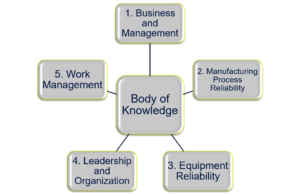 If you have been in maintenance or reliability for a period time, there is little doubt that you haven’t heard about the SMRP Body of Knowledge yet. The SMRP body of knowledge is more than just a document that outline of topics related to maintenance & reliability. It is a framework in which the CMRP exam is based on and can be used as a framework to improve your facility’s performance.
If you have been in maintenance or reliability for a period time, there is little doubt that you haven’t heard about the SMRP Body of Knowledge yet. The SMRP body of knowledge is more than just a document that outline of topics related to maintenance & reliability. It is a framework in which the CMRP exam is based on and can be used as a framework to improve your facility’s performance.
Why understanding and using the Body of Knowledge can accelerate your reliability improvement.
So how does understanding and using the Body of Knowledge accelerate your current maintenance & reliability program? Well, it provides a framework and outline of what should be in a good program. It also covers some foundational elements, such as project management, change management, etc. All of which are required to start and sustain the program.
The Body of Knowledge, however, does not tell you how to implement a maintenance & reliability program. Why does it not provide the how to? Well, every maintenance & reliability program has the same elements, but they are all very different. The programs must be designed and implemented in a way that fits with the business and is specific to the business goals. These goals will vary across industries and even within industries.
What is the SMRP Body of Knowledge
The SMRP Body of Knowledge contains five distinct pillars;
- Business & Management – Describes the skills used to translate an organization’s business goals into appropriate maintenance and reliability goals that support and contribute to the organization’s business results.
- Manufacturing Process Reliability – Relates maintenance and reliability activities to the manufacturing process of the organization to ensure that maintenance and reliability activities improve the manufacturing process
- Equipment Reliability – Describes the 2 kinds of activities that apply to the equipment and processes for which the maintenance and reliability professional is accountable. First, those activities used to assess the current capabilities of the equipment and processes in term of their reliability, availability, maintainability, and criticality. Second are the activities used to select and apply the most appropriate maintenance practices, so that the equipment and processes continue to deliver their intended capabilities in the safest and most cost-effective manner.
- Organization & Leadership – Describes processes for assuring that the maintenance and reliability staff is the most qualified and best assigned to achieve the maintenance and reliability organizational goals.
- Work Management – Focuses on the skills used to get the maintenance and reliability work done. It includes scheduling and planning activities, quality assurance of maintenance activities, stores, and inventory management.
As you can see, every aspect of a good maintenance & reliability program is covered in the 5 pillars.
Applying the SMRP Body of Knowledge
In order to apply the SMRP Body of Knowledge, one must use all aspects or risk the program failing. This is because Pillar 1 is about building the business case and aligning the maintenance & reliability program with the business goals. Pillar 4 is required to make sure the right resources are in place with the right training, along with managing the significant change that will be implemented in the organization. Pillar 3 is used to select and build the right maintenance strategy and activities, in order to maintain the level of reliability designed into the equipment. The robust design is a product of other activities in Pillar 3. Pillar 2 is used to minimize the variation in the process, and ensure the product meets the quality specifications. Lastly, Pillar 5 is about ensuring the maintenance activities are carried out as planned, and the right spares are available to ensure the level of work.
Which pillars are used in which order will depend on the current state of your organization. If you have a maintenance program but are unable to execute it, you may need to focus on Pillar 5 first, while using the change management portion of pillar 4. Regardless of the approach, the pillars will provide an outline to lead your program to success.
Compliment the Body of Knowledge with the Best Practice Guide
When building a maintenance & reliability program, the current state must be measured, and actions are taken to improve it. This is where metrics come into play. Luckily, SMRP has a Best Practice Guide with most of the maintenance KPIs, along with calculation methods, best in class targets, etc. When implementing or starting to manage the program, be sure to use the Best Practice Guide.
One word of caution, do not try to measure all of the metrics available. Select a few important KPIs and start measuring those. It is ok to change which metrics are used depending on the focus of the organization. Start small and change the metrics as needed, as we don’t need the performance management portion to become its own reporting department.
Have you used the SMRP Body of Knowledge to improve your maintenance program? If you are looking to learn more about the Body of Knowledge, be sure to check out our Society of Maintenance and Reliability Professionals (SMRP) Body of Knowledge. If you have any questions about the Body of Knowledge or how it can help your organization, please feel free to contact me at mailto:jkovacevic@eruditio.com
I’m James Kovacevic
Principal Instructor at Eruditio
Where Education Meets Application
Follow @EruditioLLC
Follow @ReliableJames
Follow @HPReliability
 Ask a question or send along a comment.
Please login to view and use the contact form.
Ask a question or send along a comment.
Please login to view and use the contact form.
Leave a Reply